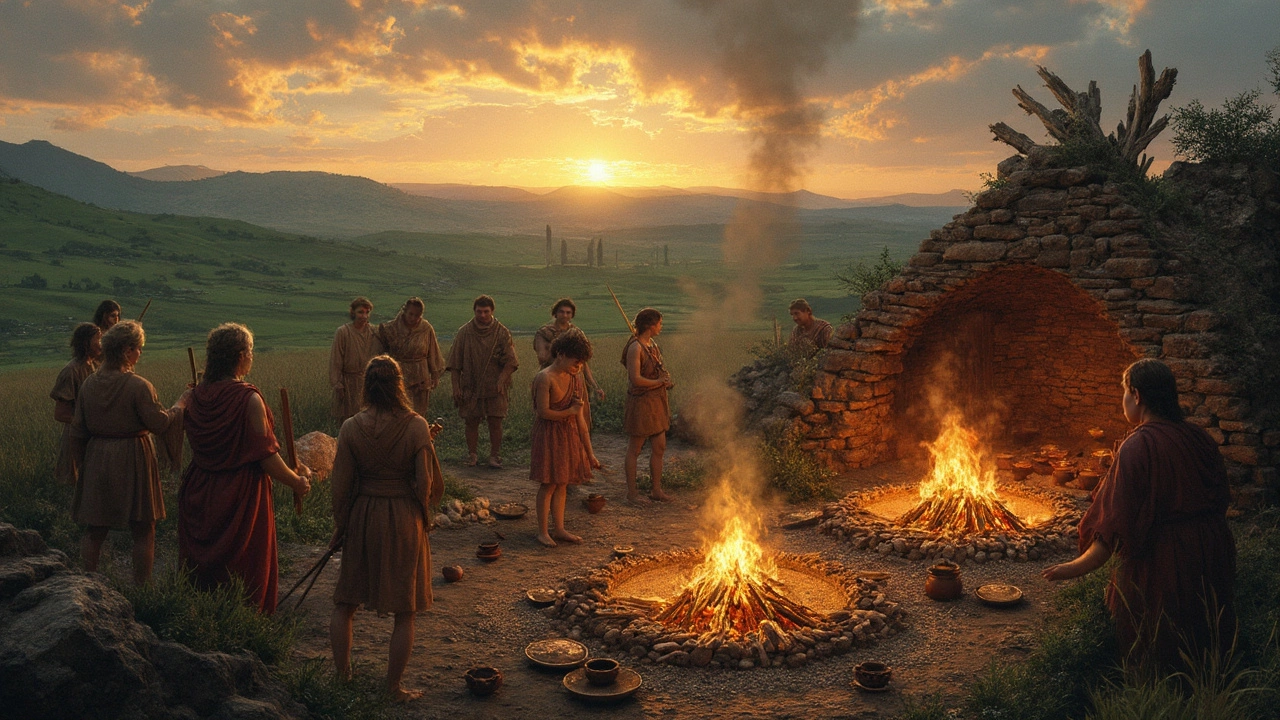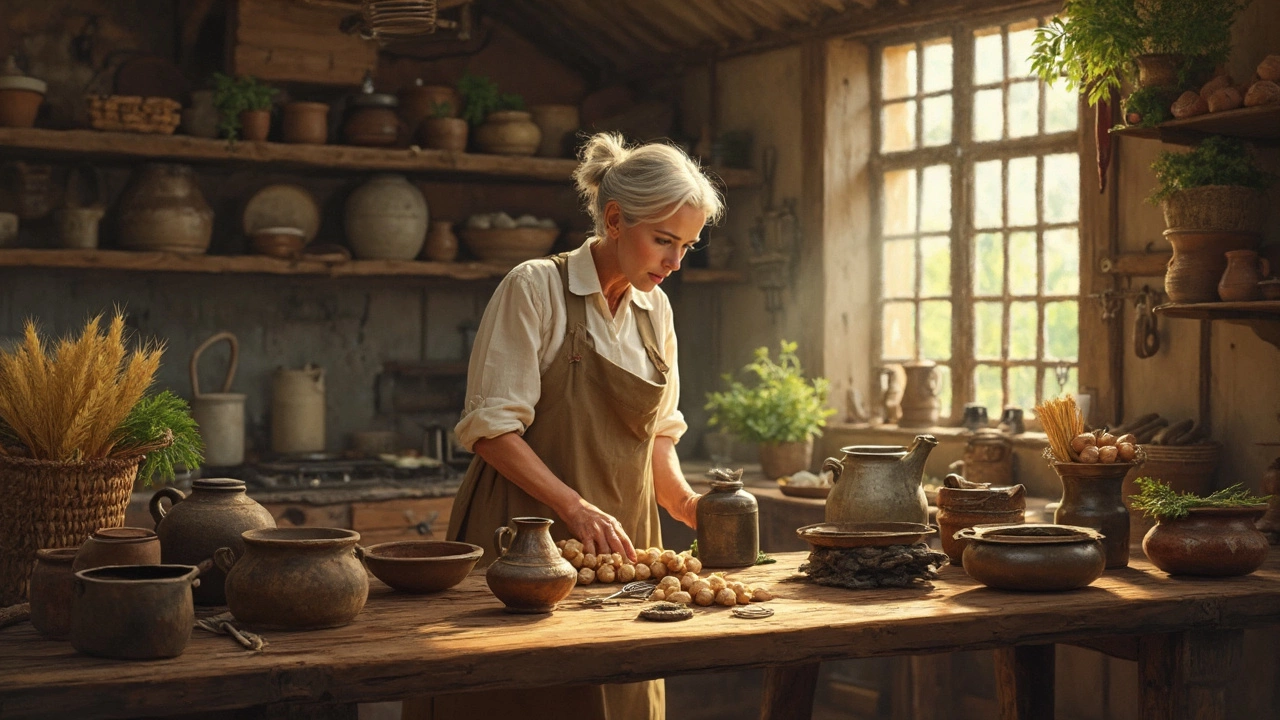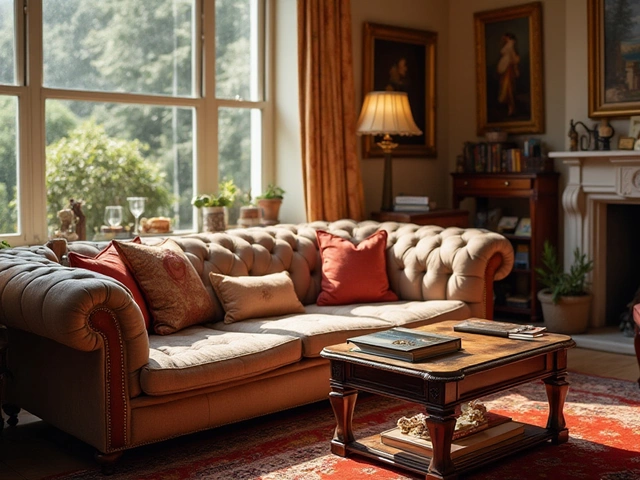If you think non-stick pans are the peak of evolution, think again—humans have been making cookware for almost 20,000 years. The oldest cooking pots ever found are simple clay vessels, chipped and darkened from sitting over smoky fires. Archaeologists found ancient shards in China, dating back at least 18,000 years. Imagine cooking soup with nothing but dirt, water, and your hands!
Why does this matter? Because a lot of what you do in your kitchen today comes straight from these old designs. That first clay pot worked kind of like a slow cooker, trapping heat, softening roots and meat, and making food much easier to eat. If you’ve ever wondered why stews are a thing all over the world, it all started with these ancient pots.
What about materials? People reached for whatever they had: stone, clay, even hollowed-out gourds. Some of these ideas stuck around. If you cook in a clay pot now—think Mexican ollas or Indian handi—you’re using a tool that’s barely changed in style since the Stone Age. And honestly, food kind of tastes different, maybe even better, when it’s cooked using one of these simple, time-proven tools. Ready to see how these early inventions shaped every meal you make now?
- Digging Up The First Pots
- Stone vs. Clay: Early Materials
- How Ancient People Cooked
- Old-School Designs Still Used Today
- Caring for Ancient-Style Cookware
- Should You Try Ancient Cookware?
Digging Up The First Pots
If you’re picturing early humans gnawing on raw meat, think again—people have been making oldest cookware for almost 20,000 years. The oldest pots archaeologists have found showed up in Xianrendong Cave, China. These clay vessels were made about 18,000 years ago, according to radiocarbon dating. That’s long before agriculture popped up, meaning hunter-gatherers managed to create and use some pretty advanced gear for the time.
These ancient pots weren’t sleek or shiny. They looked rough, hand-built with thick, uneven sides. Still, the basic idea was there: make something that holds liquid and survives a fire. What’s wild is that these pots actually changed how people ate. Suddenly, it was possible to boil water and make food safer, tastier, and more filling by cooking roots and bones.
And it wasn’t just China. Pieces of early pottery have turned up in Japan (around 16,000 years old) and Russia. The methods were similar: mix clay with water, shape it by hand, dry it, then fire it in a simple, smoky pit.
- The Chinese Xianrendong pots are the oldest so far—dated to about 18,000 years ago.
- Japanese Jōmon pottery comes close, showing up around 16,000 years ago.
- Russian finds in the Amur River region push back nearly 14,000 years.
Why did humans go through all this trouble? Boiling food unlocks nutrients and makes plants digestible. This bumped up caloric intake, which gave early people a big edge over animals that couldn’t cook.
| Location | Estimated Age (years) | Notes |
|---|---|---|
| China (Xianrendong Cave) | 18,000 | Oldest known pottery |
| Japan (Jōmon) | 16,000 | Very early decorative pots |
| Russia (Amur River) | 14,000 | Thick-walled clay pots |
So, every time you stir a soup or steam veggies, you’re taking part in a tradition that goes right back to the dawn of modern cooking. Those first pots didn’t just mean hot food—they helped humans get smarter, healthier, and, well, more creative in the kitchen.
Stone vs. Clay: Early Materials
When it comes to the oldest cookware, it’s all about stone and clay. Ancient folks weren’t worried about aesthetics—they just needed something tough enough to survive direct heat and lots of use. Let’s break down how these materials shaped ancient kitchens.
Stone came first. People used carved soapstone bowls and even flat rocks as early frying pans. You’d see these in places where good clay was hard to find, like northern Europe or ice age Japan—making do with what was underfoot. Even now, you’ll spot carved stone grills and pots in places like Korea, where dolsot stone bowls are part of daily cooking. These things last ages, but they’re heavy and can crack if you aren’t careful.
Clay changed everything. Once potters figured out how to shape and bake clay, it opened up a whole new world for cooking. Around 18,000 B.C. in southern China, fired clay pots started popping up. These pots spread everywhere because clay holds heat surprisingly well and is much lighter than a chunk of stone.
“The invention of pottery transformed early diets by allowing humans to boil roots, grains, and meat, making calories and nutrients way more accessible,” says Dr. Shi Biao, archaeologist at Hunan University.
Here’s a quick look at what made each material tick:
| Material | Earliest Use | Pros | Cons |
|---|---|---|---|
| Stone | Before 20,000 BC | Durable, retains heat, non-porous | Heavy, tricky to shape, can crack with thermal shock |
| Clay | About 18,000 BC | Lightweight, easy to shape, cheap, good heat retention | Can break if dropped, sometimes porous unless glazed |
Not sure which ancient material is better for actual cooking today? Most people go for clay pots when they want that earthy, slow-cooked flavor—plus they’re easier to use if you’re not looking to lift weights while you prep dinner. But stone still has its fans, especially for grilling or dishes that need steady, strong heat. Either way, both jump-started the whole idea of cooked meals and kitchen gear as we know them.
How Ancient People Cooked
Cooking in ancient times was pretty hands-on. Forget stoves and microwaves. Early cooks set their pots right on hot coals or tucked them in the ashes of a fire. Sometimes, they’d hang a pot over a fire using sticks or primitive tripods—think of it like early outdoor camping gear but for survival.
Most ancient cookware was made from clay. Cooks would form a pot, dry it, and fire it in an open flame. These clay pots could withstand direct heat but needed to be handled with care to avoid breaking. In places where clay was scarce, people sometimes carved pots from stone or used large shells and hollowed-out logs instead.
The oldest cookware ever found—clay pots from Xianrendong Cave in China—shows that these vessels were mainly used for boiling. This method was a game-changer: boiling made food softer, safer, and easier to digest. Roasting over open flames had been the go-to for thousands of years before, but pots let people cook grains, tough roots, and even small animals together in one dish.
Here’s how a simple, ancient cooking session went down:
- First, they’d build a good fire with dried wood.
- Next, the pot would go on the hot coals, not right in the flames—direct flames could crack it.
- They’d toss in water, roots, seeds, or meat—whatever was on hand.
- Food simmered for hours (patience was a must), picking up tasty smoky flavors from the fire.
- Stirring happened with wooden sticks or bones—nothing fancy needed.
Ancient folks didn’t have timers, so judging doneness was all about experience. They learned to read the steam, listen for bubbles, and smell when food was ready.
Across the globe, different regions used creative tweaks. In Japan, Jomon pots date back over 10,000 years. In the Middle East, people used flat stones to bake breads. Here’s a look at some ancient cookware in action:
| Region | Cookware Type | Estimated Age (years ago) | Main Cooking Method |
|---|---|---|---|
| China | Clay Pot | 18,000 | Boiling/Simmering |
| Japan | Jomon Pot | 10,000 | Boiling/Stewing |
| Middle East | Flat Stone | 9,000 | Baking/Grilling |
| Africa | Soapstone Pot | 8,000 | Boiling/Stewing |
Trying out any modern version of these old methods is a great way to experience how people cooked for most of human history. The next time you fire up a clay pot, just remember—it’s a tool that’s helped families eat together since the dawn of cooking itself.

Old-School Designs Still Used Today
It’s wild how much of our modern cookware still copies ancient styles. Want proof? Think about clay pots, cast iron pans, or even the humble Dutch oven. These aren’t just history lessons; they’re still used every day in kitchens all over the world, sometimes with almost no changes in design since people started cooking.
Oldest cookware options, like unglazed clay pots, are at the core of dishes in places like Mexico (ollas de barro), India (handi and tandoor), and Morocco (tagine). The science is simple: these materials spread heat gradually and keep in moisture, making food super tender. Tagines from Morocco, with their cone-shaped tops, help steam cycle back down into the dish, making even cheap cuts of meat melt-in-your-mouth soft.
Cast iron is another champion. The oldest-known cast iron pans popped up in China around the 5th century BCE, and you can walk into a store and buy one today that works just the same. Why? They hold heat like nothing else, making them perfect for steaks, cornbread, or even baking bread if you don’t have fancy gear. People still pass down good cast iron pans through generations.
Let’s compare a few old-school cookware designs still rocking kitchens today:
| Cookware Name | Origin | What Makes It Special |
|---|---|---|
| Clay Pot | East Asia, Middle East, Latin America | Makes stews flavorful, keeps food super juicy |
| Tagine | Morocco | Recycles steam, slow cooks tough meats |
| Cast Iron Pan | China, Europe | Unbeatable heat retention, lasts forever |
| Dutch Oven | Netherlands | Multi-purpose, great for baking and braising |
And here’s the cool part—you don’t need to be a chef to use these. Clay pots and tagines just need a quick soak before cooking (so they don’t crack), and cast iron pans like a bit of oil after each use to stay non-stick. Next time you pull out a Dutch oven or bake in cast iron, remember you’re using a piece of tech that’s outlived entire empires. Pretty awesome, right?
Caring for Ancient-Style Cookware
If you’ve ever picked up a clay pot at a market or inherited a rustic pan from family, you know these old-school pieces need something different from your average non-stick pan. With a little care, though, they can last for decades, if not centuries. Here’s what you need to keep them cooking—not crumbling.
For starters, never toss a clay or stone pot straight into a hot oven or flame. They can crack from thermal shock. Instead, let them warm up with the heat. Always check instructions, but this old rule works for most: gradual heating keeps oldest cookware safe.
Water is both a friend and enemy to clay and stone. You’ve got to wash them, but avoid harsh soap. Soap can get soaked into the pores and affect the next meal. Just use warm water and a soft brush. If food is stuck, try soaking the pot overnight—never scrub it with steel wool or anything rough.
- Never use a dishwasher. Old-style cookware needs gentle hands. High-pressure jets and soap will ruin them.
- Dry completely. Let your pot air dry upside down. If you store it wet, you invite mold.
- Seasoning helps. For unglazed pieces, rubbing the surface with a little oil and baking at a low temp can create a mild nonstick layer and protect it from water damage.
Cast iron pans—a little younger but still ancient in style—need seasoning too. After washing, dry them right away and rub in a thin coat of oil. If you let iron soak or air dry, rust will set in. Store with a paper towel inside to soak up any moisture.
Here’s a quick look at what works for each material:
| Type | Washing | Seasoning | Storage |
|---|---|---|---|
| Clay | Warm water, no soap | Oil occasionally | Dry upside down, cool place |
| Stone | Warm water, no soap | Rarely needed | Dry thoroughly |
| Cast Iron | Mild soap or none | Oil after every wash | Dry completely, paper towel inside |
Tip for first-timers: cook with plenty of water the first few times to help the cookware seal up naturally. And go easy on acids—like vinegar or tomatoes—the first few times, especially with clay or stone. Once your pot is ready, it will reward you with food that tastes like old times, in the best way possible.
Should You Try Ancient Cookware?
If you’re tempted by the idea of cooking like our ancestors, you’re definitely not alone. Using ancient cookware isn’t just about looking cool in the kitchen—it can change the way your food tastes and even make meals healthier. The most important thing? Folks still reach for oldest cookware like clay pots, especially in places like India, Mexico, and parts of Africa, where tradition and flavor matter.
Cooking in unglazed clay pots is said to bring out deeper flavors in everything from beans to rice to slow-cooked meat. Natural minerals in clay can make water softer, and the gentle heat keeps food moist. Plus, clay pots don’t leach chemicals into your food like some newer materials have been known to do. In fact, a 2012 study in the International Journal of Food Sciences and Nutrition showed that rice cooked in clay pots retained 3-4% more minerals than rice from steel or aluminum pans. That may not seem huge, but over a year of daily cooking, that’s a lot of nutrients you’d otherwise lose.
Here’s what you should know before giving ancient cookware a shot:
- Clay needs care: Always soak a new clay pot in water for 24 hours before the first use. It prevents cracking and helps the pot slowly adjust to heat.
- Start slow: Heat clay pots gradually. Never pop them straight onto a high flame—they can crack.
- Hand-wash only: Skip the soap and dishwasher. Rinse with hot water and scrub with a brush to keep the clay's natural surface.
- Avoid sudden changes: Let the pot cool down before washing or setting it on a cold surface. Clay hates quick changes in temperature.
Some cooks swear by cast iron for the same old-school reasons. It’s tough, heats evenly, and if you treat it right, lasts for generations. Just remember—no acid-heavy dishes (like tomato sauce) at first, and always dry it well to keep rust away.
To help compare at a glance, here’s how some classic ancient cookware stacks up in modern kitchens:
| Type | Main Material | Pros | Cons |
|---|---|---|---|
| Clay Pot | Clay/earth | Adds real flavor, keeps food moist, all natural | Breaks easily, takes skill to use |
| Cast Iron Pan | Iron | Lasts forever, great for searing, adds iron | Heavy, can rust, needs seasoning |
| Stone Bowl | Granite/stone | Stays hot long, looks cool | Very heavy, breaks if dropped |
If you’re ready for a little adventure, try swapping out your regular pan for something ancient one weekend. You might be surprised—your food could turn out tastier, and you might find yourself loving a bit of history with every meal. Give it a try; lots of home cooks say they’d never go back.







